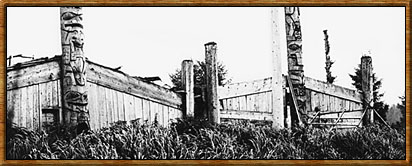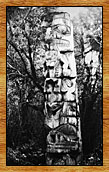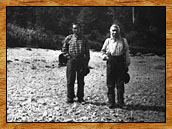 
|
Kung

House That Can Hold a Great Crowd of People (left) and Steel House (right).
Photograph by George M. Dawson, 1878.
National Archives of Canada, 264
Kung (or Dream Town) was a thriving community of fifteen houses and 280 inhabitants in 1840, according to John Work. On the east side of the village, the remains of a row of houses that appear to be at least several hundred years old suggest an even larger population long ago. The village chief in 1840 was Gulas of the Up-Inlet Town People of the Eagle moiety. A closely related Eagle family shared the eastern half of the town with them, while the Stastas Eagles and a single household of Rose Spit Ravens lived in the western half.
In 1850, Albert Edward Edenshaw, realizing that Kiusta had lost its economic and strategic importance, abandoned his Story House there. He resettled at Kung and built an elaborate dwelling named House That Can Hold a Great Crowd of People. Its architecture has many features of the Kaigani Haida style, such as tall square corner posts, which reveal Chief Edenshaw's strong ties with Haida towns in Alaska. The house next to it was Steel House, so called because it was fortified with the addition of extra horizontal planks to the walls so that no one could shoot the inhabitants through the cracks. Edenshaw also erected a pole in the early 1860s in Kung in honour of Governor James Douglas's fairness to native people; the pole portrays Douglas dressed in his frock coat and tall hat. At about the same time, villages in Alaska were raising poles in Abraham Lincoln's honour for freeing the slaves.

 |
The interior pole of Albert Edward Edenshaw's house at Kung. The figure at the top is Skungo, a man who dwelt in cave near Kiusta and who was transformed into a monster because he was living on raw fish and birds. The Bear and Frog at the centre are crests often used by Edenshaw, while the large figure at the base looks like a bear but is similar to a being on an interior house pole from Skidegate carved by his nephew Charles Edenshaw, which retains its beak and is clearly a Thunderbird.
Photograph by Charles F. Newcombe, 1913. |

About 1875, Albert Edward Edenshaw moved again, this time to Yatze (or Knife Village) at the head of Naden Harbour, in the hope of encouraging more Alaskan trade. George M. Dawson notes on his 1878 visit to Kung:
The village just within the narrow entrance to Virago Sound, from which these people are removing, is called Kung; it has been a substantial and well constructed one, but is now rather decayed, though some of the houses are still inhabited. The houses arranged along the edge of a low bank, facing a fine sandy beach, are eight to ten in number, some of them quite large. The carved posts are not numerous, though in a few instances elaborate.

 |
This pole was erected by Albert Edward Edenshaw at the village of Yatze in 1878. The bottom figure may have been carved by Charles Edenshaw or John Robson. The Raven at the top sits on a mythic being called Kaga, who was his uncle and with whom he had a quarrel. The Raven landed on Kaga with such force that he split him open. The next figure is a Sea Wolf, followed by a Beaver with prominent incisors. The small figure below that at the front of the pole is a Mountain Hawk, and at the base is a Mountain Goat that is similar to the one on Chief Skedans's mortuary post at Skidegate.
Photograph by Marius Barbeau, 1947. |

By the time Newton Chittenden, a provincial government surveyor, stopped at Kung in 1884, it had been abandoned as a permanent village. Yatze had been abandoned the year before, when Albert Edward Edenshaw moved to Masset, but the site continued to be used as a halibut fishing camp until at least the First World War, and smaller temporary houses were built near the beach.

 |
Albert Edward Edenshaw and Wiah, the town chief of Masset, on the beach at Yatze village.
Photograph by George M. Dawson, 1878. National Archives of Canada 38147 |

Very few objects were collected at Kung, since it was off the usual visitors' track. Most of the valuable items were taken along by their owners when they moved to Masset. George A. Dorsey, an anthropologist, helped himself to the contents of many Haida graves at Kung, and these objects are now in the Field Museum in Chicago. Dorsey describes one unusual grave:
The grave of the old chief at Kung was the best I had seen. Four short, stout posts had been firmly planted in the ground, and on the inner corners of each grooves had been cut out to receive the beams that supported the little house, in which lay the chief in state. The structure was nearly buried in a thick growth of vegetation, and much work with the axe was needed before the beautifully carved posts could be rendered visible to the camera.
Dorsey explored numerous other graves at Kung, including those of shaman:
What proved of special interest were several very old graves which faced the beach on the east side of the village. These were the burial places of medicine men or Shamans, and quite different from the ordinary grave, instead of a single pole in which the body is placed through a hole in the top or at the side, or from the double pole platform grave which we saw at Kung. We found a little house built of short cedar logs. Inside was placed the Shaman in a long coffin-box reclining at full length with his rattles and other ceremonial paraphernalia about him. With one had been placed several very fine masks, but they were almost entirely crumbled into dust.
|